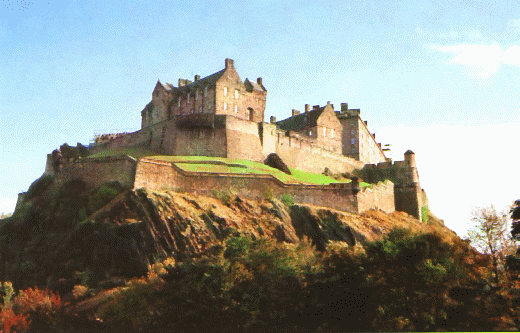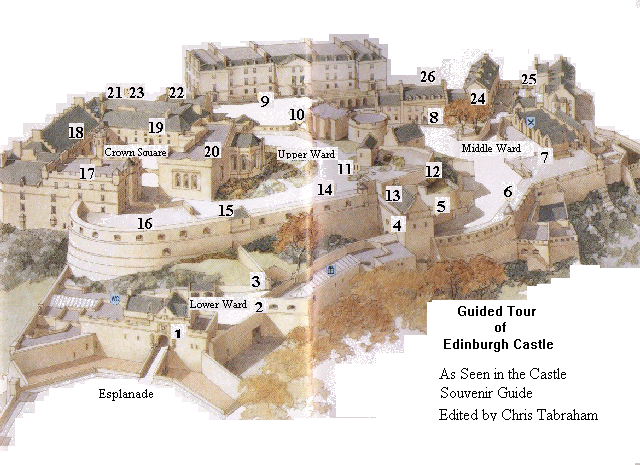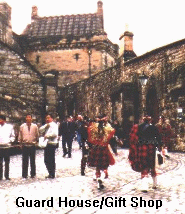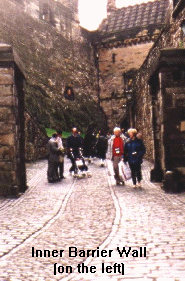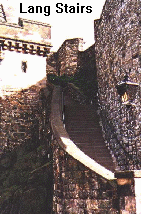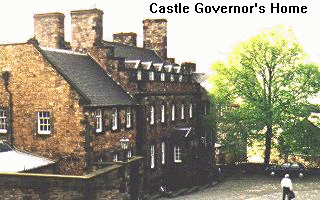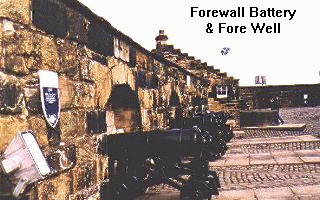Edinburgh Castle
Edinburgh Castle
Edinburgh Castle is a 'must see' castle if you ever find yourselves in the Edinburgh area- however- it should be said that it can't be truly seen if in a rush... which is what happened when I was there. I would have loved to stay longer and explore more, but that day the castle was closing early due to a visit from Prince Andrew. As it was, we had stopped at Dunnottar on the way in to Edinburgh from Aberdeen, so we didn't make it into Edinburgh until the afternoon, and by the time a B&B was sorted, and lunch was had, it was closer to late afternoon by the time we arrived at the castle (and what an upill hike that was- with a stroller to boot!). The neatest thing about the castle is that upon entering, you can get a headphone set from a kiosk, and have your very own guided tour of the castle. Throughout the castle there are plaques drawing visitors to the most significant areas of the castle, and each one is numbered, giving quick info- then the headphone set gives a much more detailed account of that particular spot.
The castle itself sits upon an extinct volcano, and has been occupied according to archaeological experts, since prehistoric times. The rock is approx 90 meters high, and oval-shaped. The oldest standing building is St. Margaret's Chapel, which was built sometime during the reign of David I (1124-1153).
Saint Margaret was David's mother, and died at the castle in 1093. It remained a chapel for the royal family's use until the 16th century, when it became a gunpowder magazine. It was restored in 1845 once it was realized what it's original purpose had been. To look at on the outside, the chapel is very plain and non-descript, but on the inside it is really something else! it is all whitewashed, with a Romanesque Arch that divides the interior in two, and overall, it really seems to capture the essence of what a service would have been like in there 800+ years ago.
There are too many buildings within the castle to name and describe them all here, so I will just tell you of a few...The Royal Palace can be seen from the parking lot (Esplanade- an 18th century parade ground where the Edinburgh Tattoo is now held). It dates back to the reign of James I. This was the residence of the later Stewart Kings and Queens, and has undergone many alterations and additions over the centuries. Two rooms within the palace are of special interest- the first being a small chamber where Mary Queen of Scots (1542-67) gave birth to James VI on June 19, 1566. James VI of course later became James I of England. The second room houses the Scottish Royal Regalia (as mentioned in the page on Dunnottar Castle). they were actually walled up in this room in 1707 and then rediscovered and put on display in 1818.
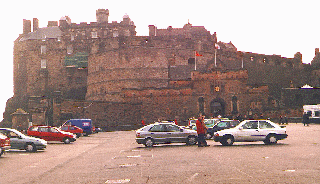
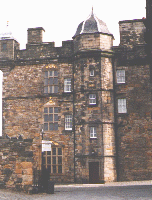 Royal Palace to Left
side view of Royal Palace
Royal Palace to Left
side view of Royal Palace
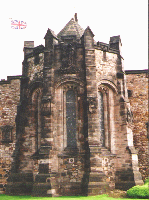
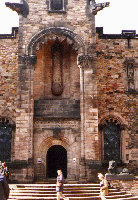 Scottish War Memorial Entrance to War Memorial
Scottish War Memorial Entrance to War Memorial
1. The Gatehouse- Built 1886-88
2. Old Guardhouse-(1853), ext.1866 to include a prison, & converted in 1989 to the Castle Gift Shop
3. Inner Barrier- Built in 17th century as an obstacle between the outer/inner most gates
4. Portcullis Gate- 16th century- had 2 outer doors, a portcullis, and an inner door
5. Lang Stairs- 70 steps providing access to the summit, built by French Prisoners in16th century
6. Argyle Battery- The six-gun battery, rebuilt in 1730's- principle artillary defense for north side of the castle
7. Cartshed- Built mid 1700's- now the castle restaurant- held up to 50 carts for bringing provisions from town
8. Governor's house-(1742) Castle Governor's residence, with lodgings for Master Gunner & Storekeeper
9. New Barracks- Built 1796-99 accomodated infantry battillion of 600
10. Foog's Gate- origin and date unknown, but served as the main gate to the Upper Ward
11. St. Margaret's Chapel- Oldest surviving structure, built during King David's reign (1124-53)
12. Dog Cemetery- small garden used since 1840's as burial place for officer's pet dogs, and mascots
13. Argyle Tower- housed vault for the 16th century portcullis
14. Forewall Battery- Rebuilt 1544, heightened after 1573 seige, armed with iron guns made in 1810
15. Fore Well- main water supply for the Upper Ward as early as the 14th century
16. Half-moon Battery- Built after Lang Seige of 1571-3 as main high level battery on vulnerable east front
17. Palace- residence for Stewart kings and queens; houses Scottish Royal Regalia
18. Great Hall- built early 16th century as the main place for ceremonies and state assemblies
19. Queen Anne Building- housed kitchens for great hall in middle ages, then army barracks 1708
20. Scottish National War Museum- see earlier description
21. Castle Vaults- 15th century used as stores, barracks, bakehouse, and prison
22. Military Prison- built 1842 for soldiers from garrison, last used 1923
23. Dury's Battery- main south facing battery, built between 1708-1713
24. Ordnance Storehouse- stores for arms and military equipment mid 1700's
25. Hospital- mid 1700's- original use was same as above; converted to military hospital 1897
26. Back Well- cut out of the basalt in 1628 to improve water supply
My Photographs of some of the above
Edinburgh Castle is located in the center of Edinburgh
